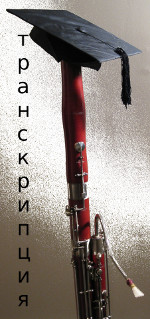Weissenborn Opus 8/2, Study #28for advanced bassoon students. Guest performer Austin Davis. Practicing with rhythms in 6/8 time. More practice with drones. The five components for sound production. First discussion on tuning. By Terry B. Ewell, Bassoon Digital Professor. Translated by Elena Iakovleva. BDP#136. www.2reed.net.
Вайсенборн опус 8/2, этюд №28 для продвинутых студентов фаготистов. Приглашенный исполнитель, Austin Davis. Тренировка с ритмами в размере 6/8. Занятия с дронами. Пять компонентов для производства звука. Первое обсуждение насчет интонации.Терри Б. Юэлл, Цифровой Профессор Фагота. Перевод, Елена Яковлева. BDP # 136. www.2reed.net.
TUTORIAL/Руководство
1. Welcome, this is Terry Ewell. Weissenborn study #28 provides us the opportunity to develop our tools for practicing in 6/8. Pull out your “toolbox” of rhythms and get to work! I want you to come up with at least six practice rhythms for the first two measures. Some should coincide with the beat and others won’t. Stop the video now.1. Добро пожаловать, это Терри Юэлл. 28-й этюд Вайссенборна дает нам возможность разработать способы для занятия в размере 6/8. Достаньте свой «набор» ритмов и приступайте к работе! Я хочу, чтобы вы придумали как минимум шесть ритмов для занятия первыми двумя тактами. Некоторые должны совпадать с пульсам, а некоторые нет. Остановите видео сейчас.
2. How did you do? We are now over half way through the Weissenborn studies and I expect that your understanding of how to use rhythms to practice is now well developed. Let’s compare notes. Here some of the possibilities.
2. Как у вас это получилось? Мы уже прошли более половины этюдов Вайссенборна, и я ожидаю, что ваше понимание того, как использовать ритмы в занятиях, теперь хорошо развито. Давайте сравним заметки. Вот некоторые варианты.
3. Rhythms that coincide with the beat and meter:
3. Ритмы, совпадающие с долей и с метром:

4. Ритмы, которые совпадают с долей, но изменяют метр:

5. Ритмы, которые отходят от доли и от метра:


6. Естественно, есть и другие ритмы. Будьте креативными! Обязательно позанимайтесь всеми трудными кусками этого этюда с множеством ритмических вариантов.
7. Students struggle with keeping an even tempo and correct rhythms in line 2. The key to a steady rhythm is subdivisions. Hear in your mind eighth notes when you perform this passage.
7. Ученикам бывает трудно поддержать темп и правильно выполнить ритмы во 2й строчке. Самое главное чтобы долбится устойчивого ритма - это разделения длительности. Думайте о восьмых нотах, когда играйте этот отрывок.
8. (singing) etc. So, if you hear those eighth notes that will help you with this passage.
8. (поет) и т. Д. Итак, если вы услышите те восьмые ноты, они помогут вам в этом пассаже.
9. Let’s also concentrate on good intonation. Set your drone to D and practice through the first four lines up to the fine.
9. Давайте также сосредоточимся на хорошей интонации. Установите свой дрон на Ре и позанимайтесь первыми четырьмя строчками, до слово fine.
10. Let me do a little practice for you to observe:
10. Я сейчас сам немного позанимаюсь, чтобы вы послушали:

11. Эти интервалы трудно настроить. Итак, мой вопрос к вам: «Как мы настраиваем ноты на фаготе?», «вы тщательно подумали об этом, или изучили вопрос интонации?». Следующие три размышления будут посвящены ответу на этот вопрос.
REFLECTION/Размышление
12. In this and the next reflection I am briefly sharing material from my monograph “Wind Performer’s Guide to Increasing Endurance.” Some of the principals introduced there will help you to better understand how to adjust intonation on the bassoon.
http://www.lulu.com/shop/terry-b-ewell/wind-performers-guide-to-increasing-endurance/ebook/product-20941958.html
12. В этом и следующем размышлении я кратко поделюсь материалом из моей монографии «Учебник для духовиков для повышения выносливости». Некоторые из представленных там принципов помогут вам лучше понять, как регулировать интонацию на фаготе.
13. Here are the five components used for the production of sound:1. the lungs
2. the throat area
3. the back of the tongue
4. the front of the tongue,
and 5. the embouchure (lips and jaw)
13. Вот пять компонентов, которые используются для извлечения звука:
1. легкие
2. область горла
3. задняя часть языка
4. передняя часть языка,
и 5. амбушюр (губы и челюсть)
14. My system for playing the bassoon treats each component independently. In other words, each component has a unique role.
14. Моя система игры на фаготе обращается с каждому компоненту по отдельности. Другими словами, каждый компонент играет уникальную роль.
15. An analogy that helps explain the roles is a faucet with a hose and trigger sprayer or nozzle. Please observe the numbers and how they correlate to the five components in the previous figure.
15. Аналогия, которая помогает объяснить роли, - это кран со шлангом и распылителем. Обратите внимание на цифры и их соотношение с пятью компонентами предыдущего рисунка.
16. In number 1 the faucet provides the flow of water. Numbers 2 and 3 direct and modify that flow of water. In number 4 the trigger on the sprayer can quickly start or stop the water. And last of all in number 5 the nozzle can direct the stream of water into a loose or tight spray.
16. В первом номере кран обеспечивает подачу воды. Номера 2 и 3 направляют и изменяют этот поток воды. В номере 4 курок на распылителе может быстро пустить или остановить воду. И, наконец, в пятом номере насадка может направить струю воды в более или менее плотный спрей.
17. Each of these components influences intonation. However, for our purposes here we will pay attention to the intonation adjustments made by the back of the tongue and the embouchure. These are components 3 and 5. We will discuss this more in the next reflection.
17. Каждый из этих компонентов влияет на интонацию. Тем не менее, для наших целей мы обратим внимание на настройку задней части языка и амбушюра. Это компоненты 3 и 5. Мы обсудим это подробнее в следующем размышлении.





